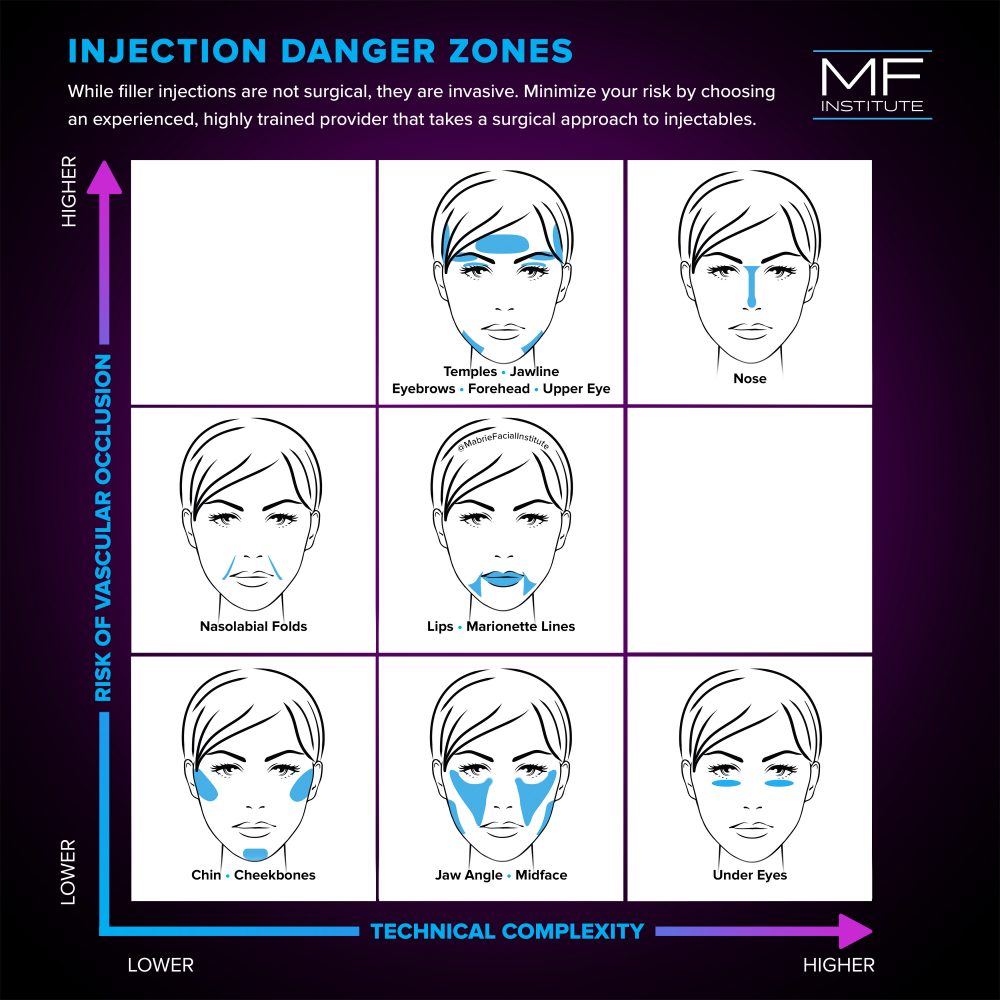Views: 0 Author: Site Editor Publish Time: 2024-05-09 Origin: Site

The under eyes and the nose are potential danger zones when treating the face with filler. These areas require the most technical skill and have a higher risk of poor results or potentially dangerous complications including vascular occlusion that can lead to skin necrosis and blindness. Choosing an experienced provider can decrease your risk of bad results.
Specifically,the six danger zones are the glabellar area, temporal region, lip and perioral area, nasolabial fold area, nasal area and the infraorbital area.
The risk of irreversible vision loss when working with the nose is high due to the proximity of the blood vessels that feed the eyes. When working with the nose, the dangerous areas are an external nasal artery and an angular artery.
Most often, cosmetologists correct the hump of the nose. In this area, it is essential to exercise caution due to the dorsal nasal artery’s proximity and the ophthalmic artery’s direct branch.
The area of the glabella – the longitudinal and transverse wrinkles between the eyebrows – is one of the most dangerous zones for dermal fillers due to the location of two critical arteries here, which connect with the ophthalmic artery that feeds the retina.
With inept correction, the result can be retinal artery blockage and blindness. When treating glabellar lines, the cosmetologist faces an additional challenge due to the small diameter of the vessels and the passage of the frontal and supraorbital arteries in this area.
Correction of the cheekbones and temples is dangerous due to the location of the temporal artery, its posterior parietal, and its anterior parietal branches. The temple’s superficial temporal artery is also connected to the ophthalmic nerve.
When a needle or cannula is inserted deep into the bone, an experienced cosmetologist bypasses this artery; this requires a highly qualified and experienced doctor.
This area becomes increasingly risky the closer the cannula is advanced towards the nose and the dorsal nasal artery, which is also connected to the ophthalmic artery.
The filler is usually inserted in the medial part under the eyes and not the lateral (closer to the edge of the face). This part of the periorbital zone requires the cosmetologist’s skill to bypass the infraorbital artery.
The cheeks appear to be the most protected part of the face, but it is not so simple. There are potentially dangerous zones in the area, such as the facial, transverse arteries, the buccal branch of the maxillary artery, and the branch of the buccal artery.
Therefore, when doing contour plastic surgery of the nasolabial fold, the beautician should pay attention to the upper labial branch of the nasal artery.
The most common area for a cosmetologist’s work requires the doctor to bypass the upper and lower labial arteries.
It is essential to understand that even innocent lip augmentation can end unexpectedly. A doctor should know where not to inject lip filler and monitor tissue discoloration and darkening (from gray to bluish shade). Worrying symptoms – ecchymosis, reticular erythema, and sharp pain at the injection site – are reasons to take immediate action.

Facial filler injections continue to grow in popularity, however their complications can be even more impressive than their aesthetic results.
Having a thorough knowledge of the pertinent anatomy and knowing the six danger zones of the face means practitioners can tailor their injection techniques to maximise safety.
Despite detailed published descriptions of the facial vasculature, the anatomy can be quite variable, and vascular injuries can occur even after the best precautions are taken.
Likewise, actual needle depth can be difficult to track and at times unpredictable. Most importantly, practitioners need to recognise complications in a timely manner and take the appropriate measures to minimise what can be a devastating result.
When performed correctly, injecting a dermal filler is a safe, non-invasive medical procedure with few side effects. However, if the injector is inexperienced or unfamiliar with facial anatomy, there are serious dangers that can cause long-term harm.
The dangers of dermal filler injection include bruising, edema, skin discoloration, infection, nodular masses, paraesthesia, and vascular compromises that could lead to skin necrosis or blindness. Fortunately, these dangers can be avoided by observing safety measures that include keeping injections away from the biggest danger zones for dermal filler injections. Additionally, dermal filler injections should only be performed by a medical practitioner who has received the proper training.
Dermal fillers can help reach incredible aesthetic results if used by a qualified person with plenty of experience in this field. Human anatomy is very complicated, there are a lot of connections, and because of irresponsible doctors who don’t know all the nuances, great harm can be done to the customers.